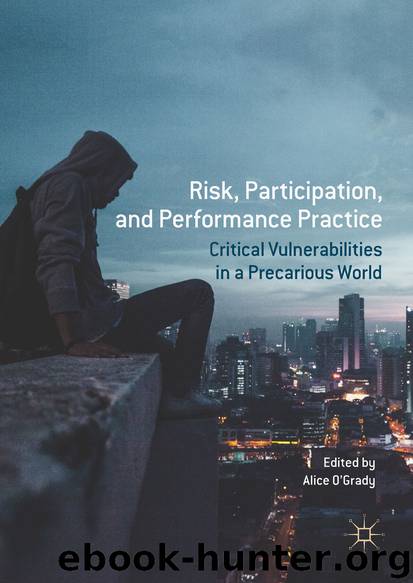Risk, Participation, and Performance Practice by Alice O'Grady

Author:Alice O'Grady
Language: eng
Format: epub
Publisher: Springer International Publishing, Cham
Closing
Bathgate, accompanied by Eszeky on guitar, sings a sultry jazz ballad, often close up on Ryan as she emerges from a sleeping bag to perform a final dance solo. Stripped down to black underwear, she sits on a bench in dialogue with the music and her own lower body; she stands, she sits, she continually picks up her legs and places them in new positions, she lies down. Alone. The lights fade on Ryan.
Performance, like an “event”, is not just something that happens “in the world”: it is a change in “the very frame through which we perceive the world and engage in it” (Žižek 2014, 10). It is the potential for reframing that vulnerability —especially sudden vulnerability—shares with performance. Vulnerability itself is not the problem. The problem is the way we—the normative we—think about vulnerability: as a pervasive injury as opposed to a creative and receptive state. Intimacy breaks the frame of vulnerability by breaking the frame of performance. The spectator is never quite sure if the textual material is dream or reality, if he or she will be called upon to enter the frame. The frame, furthermore, is both inside and outside the performance: it is both the leaky boundaries of the performance itself—its beginning, middle, and end—and the very limits of intelligibility surrounding it that “organize visual experience” (Butler 2009, 3). In this chapter I have argued for a poetics of vulnerability : that vulnerability is an interruptive value, both socially (because it upsets the myth of the autonomous self) and aesthetically (since it opens up the closed aesthetic artefact); that it invites spectators’ complicity; that vulnerability reavows structural support; and that it places both fixed identity and fixed judgement in doubt. In this chapter I have blurred the distinction between disability and vulnerability . This is done deliberately as a means of opening up a relationship between (sometimes necessarily) fixed ways of thinking about disability and the construction of new, shared ways of tackling the barriers to human flourishing. One way of defining disability , vulnerability , and performance is to view all three as an openness to affect, to being affected by pain, pleasure, art, care, and touch, in ways we cannot control and that enrich our sense of being alive, in relation to others. As Intimacy reveals, vulnerability is both a deeply theoretical problem (because it is misunderstood and because these misunderstandings frame our world) and a subjectively lived experience. What began as a personal experience of Michelle Ryan’s has become a rich aesthetic artefact that makes other readings of vulnerability possible.
Note
1.Excerpt from field notes (9 September 2014). Throughout this chapter I head each section by including observations, field notes, and quotations from and descriptions of the play. I want to give the reader a sense of being present at the work, to validate the act of spectatorship as an intersubjective experience, and to add richness to the texture of the writing: other voices heard slightly at a distance from the unitary scholarly narrative.
Download
This site does not store any files on its server. We only index and link to content provided by other sites. Please contact the content providers to delete copyright contents if any and email us, we'll remove relevant links or contents immediately.
Call Me by Your Name by André Aciman(20372)
Ready Player One by Cline Ernest(14524)
How to Be a Bawse: A Guide to Conquering Life by Lilly Singh(7391)
Wiseguy by Nicholas Pileggi(5671)
The Kite Runner by Khaled Hosseini(5083)
On Writing A Memoir of the Craft by Stephen King(4863)
Audition by Ryu Murakami(4850)
The Crown by Robert Lacey(4723)
Call me by your name by Andre Aciman(4619)
Gerald's Game by Stephen King(4582)
Harry Potter and the Cursed Child: The Journey by Harry Potter Theatrical Productions(4440)
Dialogue by Robert McKee(4321)
The Perils of Being Moderately Famous by Soha Ali Khan(4169)
Dynamic Alignment Through Imagery by Eric Franklin(4118)
Apollo 8 by Jeffrey Kluger(3637)
Seriously... I'm Kidding by Ellen DeGeneres(3577)
The Inner Game of Tennis by W. Timothy Gallwey(3575)
How to be Champion: My Autobiography by Sarah Millican(3555)
Darker by E L James(3478)
